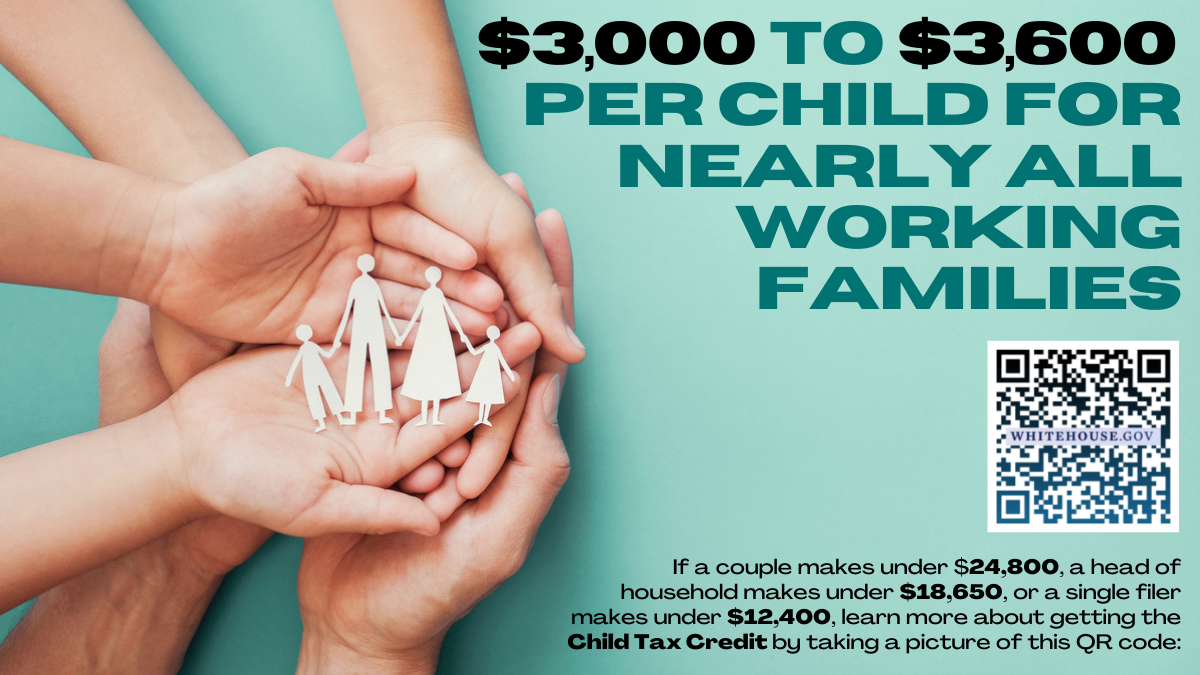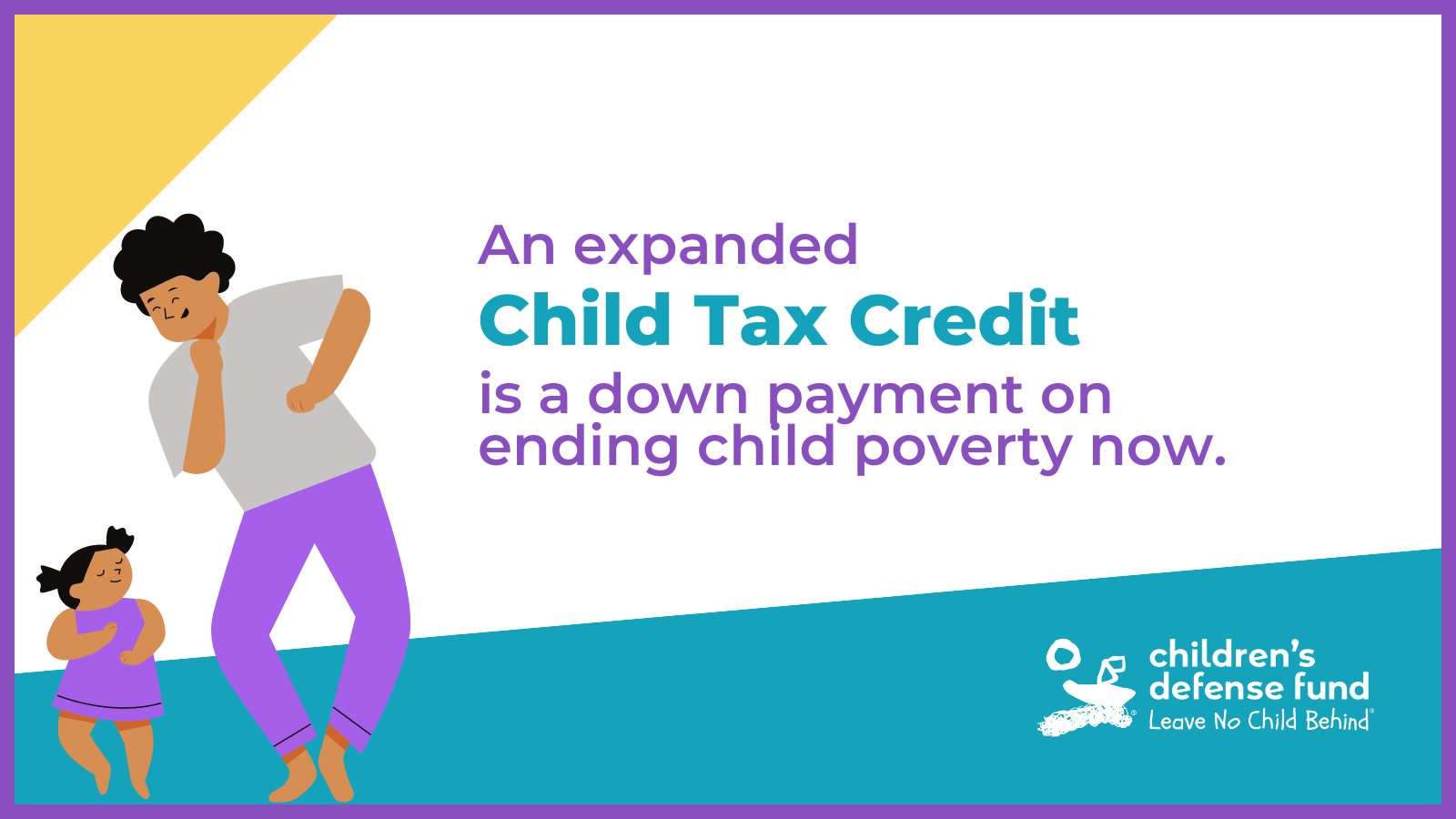
Through the air and on the ground, the campaign for Child Tax Credit awareness takes off
Earlier this week, social media activists, advocates for children and families with low incomes, religious leaders, local and state governments, elected officials and even a few famous celebrities joined the White House in a major, more-or-less coordinated push to publicize the Child Tax Credit (CTC).
By now, most of the readers of Voices for Human Needs perhaps know that beginning July 15, most families with children will begin receiving CTC payments, either through direct deposit or by mail. Families will receive $250 per month for each child age 6 through 17 and $300 per month for children younger than 6.
The IRS estimates that roughly 39 million households with 65 million children – covering almost 90 percent of children in the U.S. — will begin receiving monthly payments on July 15 without any further action required. Other eligible families – those who did not file taxes in 2019 or 2020 and who did not sign up for any of the three rounds of “stimulus” payments, including the $1,400 provided in the American Rescue Plan – can still sign up to receive monthly Child Tax Credit payments (and they’ll get those stimulus payments they missed, too).
But only if they know about it. And that’s what Monday’s CTC Awareness Day was all about.
By almost any measure, the day was a success. The CTC Awareness Day received saturation coverage throughout the U.S., from smaller media outlets all the way to the New York Times. On Twitter, the hashtag #ChildTaxCredit was trending, so much so that at one point it ranked third in activity and outpaced Paris Hilton and #NationalSelfieDay.
The Children’s Defense Fund and the Center for the Study of Social Policy took the lead in organizing a Twitterstorm during the afternoon. CHN joined with a large number of groups participating. Groups who contributed content for the event included Center on Budget and Policy Priorities, The Center for Law and Social Policy,UnidosUS, Community Legal Services, Economic Security Project, Groundwork Collaborative, No Kid Hungry, Coalition on Human Needs, Children’s HealthWatch, Americans for Tax Fairness, MomsRising, and RESULTS. Many other groups chimed in.

Scan the QR code with your phone camera to learn more.
And President Biden got into the act, tweeting, “Folks, this Child Tax Credit is a huge step towards a tax system that works for the middle class. It will lift millions of children out of poverty. This is just the first step. My American Families Plan will extend this benefit for years to come.”
But the effort to publicize the upcoming CTC payments was not limited to social media. MomsRising announced an aggressive, unprecedented effort to get the word out.
“This expanded tax credit is a once-in-a-generation opportunity to get help to some of the moms, children, and families in our country who struggle the most and to boost our economy at the same time,” said MomsRising Executive Director and CEO Kristin Rowe-Finkbeiner. “The Biden-Harris Administration is doing its part by creating a simple portal through which families can apply. We intend to do our part as well, leaving no stone unturned in working to ensure every eligible family is able to access this tax credit, which can be the difference between going hungry and putting food on the table, living in a car or a home, and accessing quality child care or leaving the workforce.”
And MomsRising was one of a number of groups that began rolling out stories of how its members would benefit from the CTC payments. The group’s press release listed three examples:
“Mary Beth in North Carolina, who cares for four school-aged grandchildren. When the pandemic hit, she was laid off from her retail job and has struggled to make ends meet. She says the expanded Child Tax Credit will help her family cover the basics like fresh, nutritious food, medications, housing, and clothing for her growing grandchildren.
“Rachel in Pennsylvania, who was devastated when COVID-19 forced her daughter’s preschool program to close permanently. Rachel was forced to take a pay cut due to the pandemic, making it difficult for her family to afford a new child care program. She says the Child Tax Credit will enable them to look for summer care for their daughter, so Rachel can focus on her work and her daughter can get ready for kindergarten.
“Single mom Tami in Kansas, who was forced to take unpaid leave from her job in the kitchen of an assisted living center, because her twins’ school closed and because Tami had open-heart surgery recently and is high-risk for COVID-19. That caused a financial crisis for her family. The Child Tax Credit will help Tami pay her utilities bills and other necessities.”

Grassroots organizers like MomsRising members already are on the ground, in some cases planning door-to-door outreach efforts, although many of these campaigns will not begin until late this summer.
In Detroit, volunteers are now being trained to go block-by-block, door-to-door in key neighborhoods that have clusters of low-income families with children to teach people who aren’t typically required to file tax returns how to apply for the benefit.
“We’re hoping to reach 2,000 families,” Jessica Brown, Director of Strategic Initiatives and Special Projects for the Community Development Advocates of Detroit, told the Detroit Free Press.
That type of outreach will be necessary – not just in Detroit but all over the U.S. — if the expanded CTC benefits are to meet their full potential. The Center on Budget and Policy Priorities has estimated that the CTC expansions alone can reduce child poverty by more than 40 percent. Other experts say the expansions – coupled with other efforts such as SNAP and rental assistance – can push child poverty reduction to more than 50 percent.
But word has to get out. Campaigning on the CTC’s behalf in Pittsburgh, PA this Monday, Vice President Harris emphasized this point.
“When more families know about how they can get the relief, that is how we will be able to lift our children out of poverty,” she said. “That is how we will be able to lift up our nation’s middle class as well.”
Spoiler alert: Next week, the new Voices for Human Needs Podcast will examine the fight against child poverty through policy choices, including tax credits. It will focus on how policy has addressed children historically, the impact of changing policy for children and families who rely on certain benefits as we find our way out of the pandemic, and how the recently passed American Rescue Plan and proposed American Families and Jobs Plans are revolutionizing the policy landscape regarding investments in children. Head to our Anchor site to see all the podcast distribution platforms we are on: Apple Podcast, Google Podcast, or Spotify. Or simply search for “Voices for Human Needs” wherever you get your podcast.

